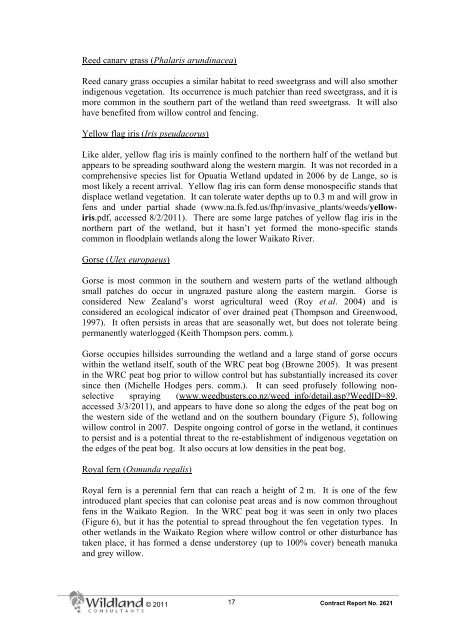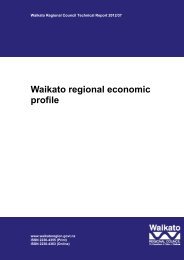Opuatia Peat Bog Management Plan - Waikato Regional Council
Opuatia Peat Bog Management Plan - Waikato Regional Council
Opuatia Peat Bog Management Plan - Waikato Regional Council
You also want an ePaper? Increase the reach of your titles
YUMPU automatically turns print PDFs into web optimized ePapers that Google loves.
Reed canary grass (Phalaris arundinacea)<br />
Reed canary grass occupies a similar habitat to reed sweetgrass and will also smother<br />
indigenous vegetation. Its occurrence is much patchier than reed sweetgrass, and it is<br />
more common in the southern part of the wetland than reed sweetgrass. It will also<br />
have benefited from willow control and fencing.<br />
Yellow flag iris (Iris pseudacorus)<br />
Like alder, yellow flag iris is mainly confined to the northern half of the wetland but<br />
appears to be spreading southward along the western margin. It was not recorded in a<br />
comprehensive species list for <strong>Opuatia</strong> Wetland updated in 2006 by de Lange, so is<br />
most likely a recent arrival. Yellow flag iris can form dense monospecific stands that<br />
displace wetland vegetation. It can tolerate water depths up to 0.3 m and will grow in<br />
fens and under partial shade (www.na.fs.fed.us/fhp/invasive_plants/weeds/yellowiris.pdf,<br />
accessed 8/2/2011). There are some large patches of yellow flag iris in the<br />
northern part of the wetland, but it hasn’t yet formed the mono-specific stands<br />
common in floodplain wetlands along the lower <strong>Waikato</strong> River.<br />
Gorse (Ulex europaeus)<br />
Gorse is most common in the southern and western parts of the wetland although<br />
small patches do occur in ungrazed pasture along the eastern margin. Gorse is<br />
considered New Zealand’s worst agricultural weed (Roy et al. 2004) and is<br />
considered an ecological indicator of over drained peat (Thompson and Greenwood,<br />
1997). It often persists in areas that are seasonally wet, but does not tolerate being<br />
permanently waterlogged (Keith Thompson pers. comm.).<br />
Gorse occupies hillsides surrounding the wetland and a large stand of gorse occurs<br />
within the wetland itself, south of the WRC peat bog (Browne 2005). It was present<br />
in the WRC peat bog prior to willow control but has substantially increased its cover<br />
since then (Michelle Hodges pers. comm.). It can seed profusely following nonselective<br />
spraying (www.weedbusters.co.nz/weed_info/detail.asp?WeedID=89,<br />
accessed 3/3/2011), and appears to have done so along the edges of the peat bog on<br />
the western side of the wetland and on the southern boundary (Figure 5), following<br />
willow control in 2007. Despite ongoing control of gorse in the wetland, it continues<br />
to persist and is a potential threat to the re-establishment of indigenous vegetation on<br />
the edges of the peat bog. It also occurs at low densities in the peat bog.<br />
Royal fern (Osmunda regalis)<br />
Royal fern is a perennial fern that can reach a height of 2 m. It is one of the few<br />
introduced plant species that can colonise peat areas and is now common throughout<br />
fens in the <strong>Waikato</strong> Region. In the WRC peat bog it was seen in only two places<br />
(Figure 6), but it has the potential to spread throughout the fen vegetation types. In<br />
other wetlands in the <strong>Waikato</strong> Region where willow control or other disturbance has<br />
taken place, it has formed a dense understorey (up to 100% cover) beneath manuka<br />
and grey willow.<br />
© 2011<br />
17<br />
Contract Report No. 2621

















